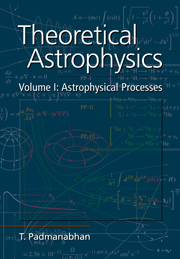Book contents
- Frontmatter
- Contents
- Preface
- Chapter 1 Order-of-Magnitude Astrophysics
- Chapter 2 Dynamics
- Chapter 3 Special Relativity, Electrodynamics, and Optics
- Chapter 4 Basics of Electromagnetic Radiation
- Chapter 5 Statistical Mechanics
- Chapter 6 Radiative Processes
- Chapter 7 Spectra
- Chapter 8 Neutral Fluids
- Chapter 9 Plasma Physics
- Chapter 10 Gravitational Dynamics
- Chapter 11 General Theory of Relativity
- Chapter 12 Basics of Nuclear Physics
- Notes and References
- Index
Chapter 12 - Basics of Nuclear Physics
Published online by Cambridge University Press: 05 June 2012
- Frontmatter
- Contents
- Preface
- Chapter 1 Order-of-Magnitude Astrophysics
- Chapter 2 Dynamics
- Chapter 3 Special Relativity, Electrodynamics, and Optics
- Chapter 4 Basics of Electromagnetic Radiation
- Chapter 5 Statistical Mechanics
- Chapter 6 Radiative Processes
- Chapter 7 Spectra
- Chapter 8 Neutral Fluids
- Chapter 9 Plasma Physics
- Chapter 10 Gravitational Dynamics
- Chapter 11 General Theory of Relativity
- Chapter 12 Basics of Nuclear Physics
- Notes and References
- Index
Summary
Introduction
This chapter introduces several concepts from nuclear physics that are used in different areas of astrophysics, especially in the study of stellar evolution. The ideas developed here will be used in the theory of stellar structure and evolution (Vol. II) and in cosmology (Vol. III).
Nuclear Structure
The nuclei of atoms contain protons and neutrons that differ – most importantly – in their electrical charge; the proton is positively charged whereas the neutron is neutral. They are both fermions with spin half and their masses are almost equal (mpc2 = 938.3 MeV for a proton and mnc2 = 939.6 MeV foraneutron). Protons, being positively charged, will repel each other and a collection of protons will fly apart because of this repulsion. They are kept together along with neutrons in a nucleus because of the existence of a stronger, attractive, nuclear force. As far as nuclear force is concerned, protons and neutrons behave in very similar manner. We may say that the nuclear force provides the necessary binding energy to keep the atomic nucleus together.
A fundamental many-body theory describing the nuclear force that acts between the nucleons is not yet fully developed. Hence it is not possible to study aspects involving nuclear forces from first principles. In what follows we rely extensively on phenomenological facts and experimental results.
Different atomic nuclei are characterised by different values of the binding energy per nucleon, Ēb.
- Type
- Chapter
- Information
- Theoretical Astrophysics , pp. 563 - 586Publisher: Cambridge University PressPrint publication year: 2000



